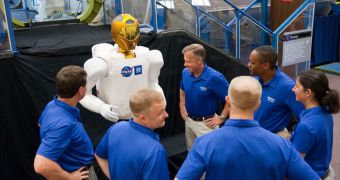Officials at the American space agency announce that the Robonaut 2 machine is now packed inside its special frame, awaiting delivery to the International Space Station (ISS). It is scheduled to fly to the outpost aboard space shuttle Discovery, during the STS-133 mission.
Reaching low-Earth orbit is never easy for astronauts, so why would their robotic counterpart be any different? NASA experts say that the aluminum frame in which R2 is currently being stored also contain foam blocks cut out to its shape.
This will ensure that the amount of vibrations the machine is exposed to is as low as possible. During a shuttle launch, excessive forces affect both the astronauts and the cargo, and so everything needs to be fasten securely into place before take-off.
“I think back in May we realized we had a huge challenge on our hands,” says of the challenges associated with getting R2 into orbit Michael Haddock. The expert is based at the Space Station Processing Facility, where he is a mechanical engineer.
The expert, who also plays a part in designing procedures associated with the launch, says that the entire R2 payload (container included) will weigh about 500 pounds when aboard the shuttle.
“The mass is what's driving the crane operations, otherwise we'd be handling the robot by hand. But the robot itself weighs on the order of 333 pounds,” the engineer reveals. He adds that R2 is the result of a partnership between NASA and General Motors.
Robonaut's launch payload is called the Structural Launch Enclosure to Effectively Protect Robonaut (SLEEPR). The main thing its designers needed to keep into account was the fact that astronauts on the ISS needed to be capable of opening it up very easily.
“We were trying to do something very unique and very fast. And we've got the best team in the world for dealing with things like that,” explains the STS-133 mission payload, manager Scott Higginbotham.
The robot is designed to help astronauts in space carry out some of the most cumbersome tasks they have to do on the outside of the space station. It has two arms and dexterous fingers, which help it grab hold of things without crushing them.
“It really grabs people's attention. It's so incredibly cool. It can use the same tools and procedures as an astronaut,” Higginbotham says. The robot will at first be installed inside the ISS, but NASA experts hope to use it for spacewalks soon.

 14 DAY TRIAL //
14 DAY TRIAL //